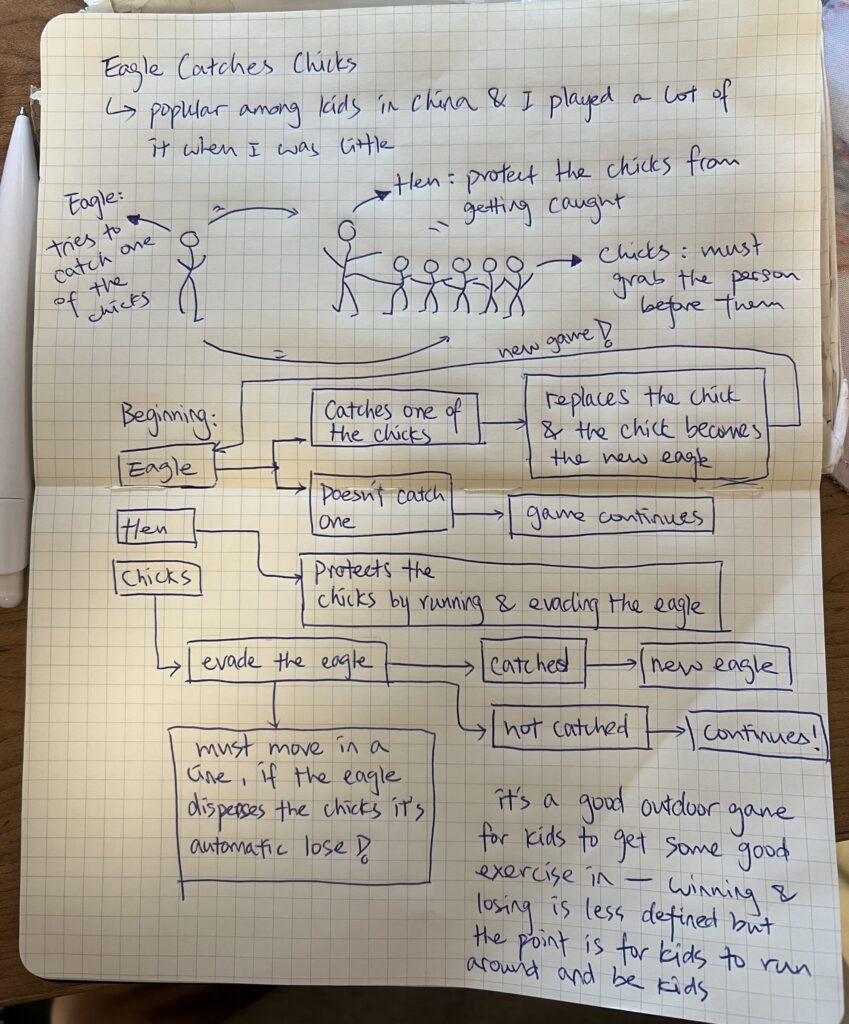1. Identify the basic elements in a game of your choice (actions, goals, rules, objects, playspace, players).
Game: 2048
Actions: The player can slide tiles in one of four directions—left, right, up, down—until they are stopped by either another tile or the edge of the grid
Goals: To reach a tile with the value of 2048 in the fewest steps possible (and when 2048 is reached, to reach a tile with the largest value possible)
Rules:
- The player can slide the tiles in one of four directions to merge adjacent tiles. When two adjacent tiles with the same value collide, they will be merged into a new tile with the combined value of the two tiles.
- A random tile will appear in the empty space after each turn
- The game ends when there are no empty spaces and no adjacent tiles with the same value
Objects:
- Tiles with integer values starting from 2 or the power of 2
- A scoreboard that increases by the value of every new tile that is created through the player’s act of merging.
- A “Best Score” board that tracks the player’s best performance
- A leaderboard where you can see the ranking of your scores among your friends and globally
Playspace: A plain 4×4 grid on a mobile screen
Players: 1 player
2. As a thought experiment, swap one element between two games: a single rule, one action, the goal, or the playspace. For example, what if you applied the playspace of chess to basketball? Imagine how the play experience would change based on this swap
If we were to apply the playspace of an artsy game such as Monument Valley (one of my favorite games for its beautiful illustration) to a competitive shooting game like Fortnite, it will completely change the overall aesthetics and atmosphere of the game. I can only imagine the shooting game to feel quite strange and absurd, and I am quite interested in that juxtaposition. It would definitely disrupt how players usually think of shooting games and add a sense of dreamlike adventure to the game. While we tend to focus on crafting the rules for our game, we must also take into consideration the artistic elements that play a huge role in creating the immersiveness a game needs. Sometimes, creating some disruption by adopting a different playspace could generate interesting results!
3. Pick a simple game you played as a child. Try to map out its space of possibility, taking into account the goals, actions, objects, rules, and playspace as the parameters inside of which you played the game. The map might be a visual flowchart or a drawing trying to show the space of possibility on a single screen or a moment in the game.

4. Pick a real-time game and a turn-based game. Observe people playing each. Make a log of all the game states for each game. After you have created the game state logs, review them to see how they show the game’s space of possibility and how the basic elements interact.
Real-time game: Monument Valley
Start State:
- The player character Princess Ida enters a new maze. The play needs to interact with the environment to find hidden passages that can lead Ida to the maze’s exit.
Game:
- The player interacts with the environment by moving the platforms, turning the pillars, and shifting the bridges.
- The player experiments with different ways they could change the environment to lead Ida in this three-dimensional maze. Oftentimes, Ida’s way would remain blocked in surprising ways despite her being able to move past initial obstacles.
- The player engages in a trial-and-error process, sometimes turning their phones upside down or sideways to observe new pathways.
Winning State:
- The player finds the exit and leads Ida to the exit, which opens up to new mazes.
Turn-based game: Tic Tac Toe
Start State:
- The two players play rock paper scissors to decide who goes first
Game:
- In a 3×3 grid, the players take turns drawing either “O” or “X” in one of the empty grid.
Winning State:
- Player 1 wins by connecting three “O”s diagonally
Real-time games provide a wider range of actions that players can perform. Therefore, the players’ actions are less predictable and therefore harder to describe in the game log. Players are also often interacting with the environment, either changing it directly like in Monument Valley, or picking up coins along the way like in Mario Kart. This means that the playspace for real-time games tends to be more immersive and complicated for the players to fully engage with the game. In turn-based games, the rules are the most important driving factors and players’ actions are often closely in line with what the rules demand. There will be less unpredictability in how the game goes—and for someone to become a master in turn-based games, they often need to come up with strategies that interact with/respond directly to the rules, since there is less creativity allowed with regard to the other elements.

